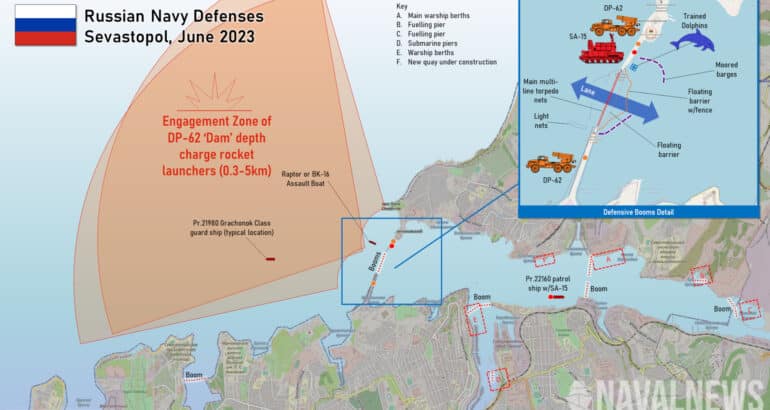https://www.navalnews.com/naval-news/2023/06/russia-dolphins-ukrainian-attacks/
Home»
News»Russia Increases Dolphins Defending Sevastopol From Ukrainian Attacks

Click to enlarge. The trained dolphins are housed just inside the harbor entrance. They are part of a multi-layered defense which counters air, surface and underwater threats. The dolphin pens appear to have been doubled in recent days.
Russia Increases Dolphins Defending Sevastopol From Ukrainian Attacks
The threat of Ukraine's elite special forces divers must loom large in the minds of the Russian Navy. As well as extensive anti-torpedo nets and rocket launchers, Russia has increased the trained dolphins guarding Sevastopol in Crimea.
H I Sutton 14 Jun 2023
Russia appears to have doubled the trained dolphins defending Sevastopol naval base in Crimea. This is part of a gradual tightening of defenses in response to Ukraine’s growing ability to reach the strategic city. Despite the wider focus on missiles and maritime drones, Russia evidently takes the threat of Ukrainian special forces seriously.
Evidence seen by
Naval News shows that the number of dolphin pens has increased. Analysis suggests that the number of animals has increased from 3-4 to 6-7.
The implication is that dolphin patrols have increased in frequency and/or cover more area. The animals will defend against Ukrainian special forces divers, known as combat swimmers, who might otherwise infiltrate the base. The marine mammals have an inherent advantage against even the most athletic combat swimmer; no one can out-swim a dolphin.
For this reason
several countries have at times trained dolphins and other marine mammals for this role. The most
famous program is in the U.S. Navy’s. But the first was in Sweden, and it is suspected that Israel, North Korea and possibly other countries also have programs.
Russia’s Trained Dolphins
Russia deployed the trained animals to a position on the north side of the harbor entrance at the
beginning of the 2022 invasion. There was already a training center for dolphins and beluga whales just outside the city, dating from Soviet times. The dolphins are native species but the belugas were flown in from colder waters. The facility had briefly been part of the Ukrainian Navy before being seized by Russia following the 2014 annexation of Crimea.
The facilities and their activities were increased under Russian control. The dolphins were occasionally deployed to Novorossiysk and even Tartus in Syria.
Today the dolphins are part of a complex multi-layer defense. Outside the harbor a special purpose ship, supported by helicopters and fast boats, guards against surface and underwater threats. This is supported by at least two DP-64 ‘Dam’ rocket-propelled depth charge systems. The harbor entrance itself is blocked by no less than five layers of nets and floating barriers. These also try to block both surface and submerged approaches.
The dolphins are inside these barriers (‘booms’) and will patrol against divers who might have slipped through. Based on observed practices the dolphins can be moved around the base on small boats. A cradle, resembling a tent, is used when the dolphins are inside the boat.
Increased Defenses
Inside the main boom defenses there are several more sets of booms across the harbor and its smaller bays.
The base also has increased air defenses. An SA-15 Gauntlet (‘Tor’) missile system is parked on the sea wall near to the depth charge rocket launchers. Another SA-15 has been strapped to the helipad of a patrol ship which is anchored further inside the base. These have a range of up to 12 km (7.5 miles) although in practice it may be less. All the same they add considerably to the close in defenses of the base.
Zooming out, the base and its approaches are also covered by anti-ship missiles, specialist artillery and S-300/S-400 long-range air defenses. Fighter jets, many based on Crimea, and electronic warfare (EW) round out the defenses.
Russia has also increased defenses in other bases and ports around Crimea. And similar defenses have started appearing in
key submarine bases in the Arctic, far away from the Ukrainian threat.
Sevastopol should not be viewed as an impenetrable fortress however. Ukrainian maritime drones have
penetrated the defenses several times, and Ukraine will no doubt be aware of weaknesses. Which is likely why Russia has felt the need to increase the dolphin defenses.
-
Posted by : H I Sutton
H I Sutton writes about the secretive and under-reported submarines, seeking out unusual and interesting vessels and technologies involved in fighting beneath the waves. Submarines, capabilities, naval special forces underwater vehicles and the changing world of underwater warfare and seabed warfare. To do this he combines the latest Open Source Intelligence (OSINT) with the traditional art and science of defense analysis. He occasionally writes non-fiction books on these topics and draws analysis-based illustrations to bring the subject to life. In addition, H I Sutton is a naval history buff and data geek. His personal website about these topics is Covert Shores (
www.hisutton.com)





